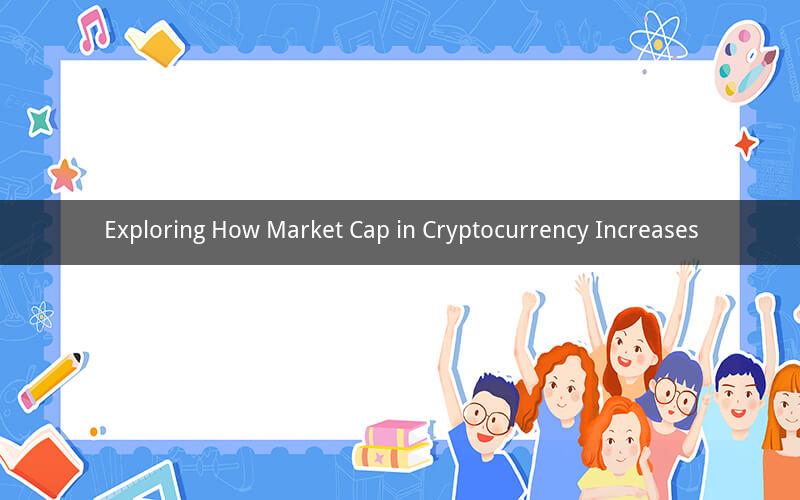
Introduction:
The cryptocurrency market has been experiencing remarkable growth over the past few years. With numerous digital currencies emerging, understanding how the market cap of a cryptocurrency increases is crucial for investors and enthusiasts. In this article, we will delve into the factors that contribute to the increase in market cap within the crypto space.
1. Supply and Demand Dynamics:
The fundamental principle of market cap in any asset, including cryptocurrencies, is based on the basic economic concept of supply and demand. When the demand for a cryptocurrency increases while the supply remains constant or decreases, the price tends to rise, leading to an increase in market cap. Conversely, if the supply increases or the demand decreases, the price may fall, resulting in a decrease in market cap.
1.1 Increase in Demand:
There are several factors that can drive an increase in demand for a cryptocurrency:
a) Adoption by Retail Investors: As more individuals become aware of the potential benefits of cryptocurrencies, they start to invest in them. This increased participation in the market can drive up demand and, consequently, the market cap.
b) Institutional Interest: Institutional investors, such as hedge funds and banks, have shown growing interest in cryptocurrencies. Their entry into the market can significantly boost demand and, in turn, the market cap.
c) Partnership and Integration: When established companies or financial institutions integrate cryptocurrencies into their services or offer support for specific cryptocurrencies, it can lead to an increase in demand and market cap.
1.2 Decrease in Supply:
There are various ways in which the supply of a cryptocurrency can decrease, leading to an increase in market cap:
a) Limited Supply: Many cryptocurrencies have a predetermined maximum supply, such as Bitcoin's 21 million coins. As the supply approaches the maximum limit, it becomes scarcer, potentially increasing the demand and market cap.
b) Token Burn: Some cryptocurrencies implement a token burning mechanism, where a certain percentage of tokens are permanently removed from circulation. This reduces the total supply and can drive up the market cap.
2. Market Sentiment and Speculation:
The sentiment and speculation within the cryptocurrency market can significantly impact market cap. Positive news, such as regulatory approvals or technological advancements, can boost investor confidence and drive up demand, leading to an increase in market cap. Conversely, negative news or uncertainty can lead to a decrease in demand and market cap.
3. Market Makers and Liquidity:
Market makers play a crucial role in maintaining liquidity in the cryptocurrency market. They provide buy and sell orders, ensuring that the market remains efficient. When market makers actively participate in a cryptocurrency, they can influence the price and market cap. Higher liquidity tends to attract more investors, leading to an increase in market cap.
4. Technological Developments and Innovation:
Technological advancements and innovation within the cryptocurrency space can drive up market cap. For example, the introduction of new features or improvements in existing cryptocurrencies can make them more attractive to investors, leading to increased demand and market cap.
5. Regulatory Environment:
The regulatory landscape plays a significant role in determining the market cap of cryptocurrencies. Positive regulatory news, such as the approval of a regulatory framework or the easing of restrictions, can boost investor confidence and drive up demand and market cap. On the other hand, negative regulatory news or uncertainty can lead to a decrease in demand and market cap.
Questions and Answers:
1. How does an increase in demand for a cryptocurrency lead to an increase in market cap?
An increase in demand for a cryptocurrency leads to an increase in market cap when the price of the cryptocurrency rises. As more individuals and institutions are willing to pay higher prices to acquire the cryptocurrency, the total value of all the coins in circulation increases, resulting in a higher market cap.
2. What are some factors that can drive institutional interest in cryptocurrencies?
Several factors can drive institutional interest in cryptocurrencies, including the potential for high returns, the diversification benefits, the increasing adoption by retail investors, and the growing acceptance as a legitimate asset class.
3. How does token burning contribute to an increase in market cap?
Token burning reduces the total supply of a cryptocurrency, making it scarcer. As a result, the demand for the remaining coins increases, leading to a higher price and, consequently, an increase in market cap.
4. How can market makers influence the market cap of a cryptocurrency?
Market makers can influence the market cap of a cryptocurrency by providing liquidity and maintaining price stability. Their active participation in the market can attract more investors, leading to increased demand and a higher market cap.
5. What impact does the regulatory environment have on the market cap of cryptocurrencies?
The regulatory environment can significantly impact the market cap of cryptocurrencies. Positive regulatory news can boost investor confidence and drive up demand, while negative news or uncertainty can lead to a decrease in demand and market cap.